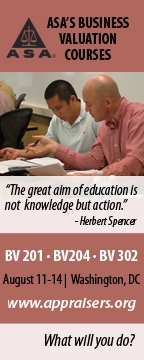
| June 15, 2011 | Issue #105-3 |
The size premium is alive and well “There has been some talk in recent years suggesting that the size premium no longer exists,” James Harrington (Duff & Phelps) told the audience at the recent CalCPA Business Valuation Conference in San Francisco. “But research that Duff & Phelps has performed (based on data from the Center for Research in Security Prices at the University of Chicago) suggests that the size premium is alive and well.” he added. To help support this assertion, Harrington presented data from three time periods: 1980−2010, 1985−2010, and 1990−2010 using the portfolio beta and average return for the 25 portfolios from Exhibit B-1 of the Duff and Phelps Risk Premium Report. The results show the size premium still exists in each of the time periods. “These periods are shorter than the longer periods we are used to looking at—but the results are quite compelling, and seem to indicate that reports of the size premium’s death may have been greatly exaggerated, to paraphrase an old saying,” he said. Look for Harrington’s article on this topic in a future Business Valuation Update. BV trivia question: Which Tax Court judge has taught quantitative analysis to lawyers? (Hint—think Peracchio) More hints: In Peracchio v. Commissioner, (T.C. Memo 2003-280), the Tax Court discredited both experts’ determination of minority and marketability discounts for a family limited partnership (FLP) funded with $2 million in cash and securities. The court criticized the taxpayer’s experts for using benchmark averages without examining and adjusting the underlying restricted stock data to fit the facts of the case, and was even “less impressed” by the IRS expert’s “brief analysis of six [unnamed] factors that may influence” the range of the marketability discount, and his “arbitrary selection” of the midpoint. Since the taxpayer failed to carry its burden of proof, the court settled on the 2% minority discount conceded by the IRS expert and the DLOM in his upper range. “I [wasn’t] there to investigate the facts,” Judge James Halpern told attendees at the recent ASA IRS Valuation Symposium in Los Angeles. “I’m not an expert but a neutral arbiter. You come to me. If [your client] has the burden of proof and you don’t tell a story to support it—you lose. If there is a factual question and neither side puts in [convincing] testimony, then it’s a tie, and a tie goes against the party with the burden of proof.” Rule 143(g), ‘required’ reading for BV appraisers Halpern also reminded BV appraisers that the U.S. Tax Court follows its own rules and procedures, analogous to but also departing in significant ways from the Federal Rules of Civil Procedure. Rule 143(g)(T.C.R.), for example, provides that unless the court otherwise permits, an expert’s complete direct testimony is set forth in his/her written report. What this means: “You may not get to open your mouth in my courtroom,” Halpern said. Only if the other side asks for cross-examination will the judge get to hear a “peep” from the expert. Trial attorney John Porter (Baker Botts LLP), a featured speaker at the recent annual meeting of Valuation Roundtable of San Francisco, seconded the judge’s reminder, advising appraisers to read (and re-read) Rule 143(g). “Even when an appraisal will only initially be used to establish the fair values of an asset in connection with the filing of a tax return, the appraisal report should be in a form which will allow the report to be introduced in subsequent litigation,” Porter said. “Preparation of the report with this potential end-use in mind is not difficult and will avoid the need to have the appraiser prepare a new or revised report in the event the matter proceeds to trial.” Given its importance in any appraiser’s reference library, we’ve made the entire text of Rule 143 (T.C.R.) available as a free download: click here.
Letter to the Editor: more on company-specific risk In response to last week’s item “The ‘one size fits all’ company-specific risk doesn’t exist,” Peter Butler (Valtrend) wrote regarding Jim Harrington’s comments on total beta, and his observation that the more important question is comparing the subject company to the selected comparables. “I agree,” Butler wrote. “We apparently only disagree on what you do next.” For example:
What lawyers want when hiring you The next time an attorney calls to interview you as an expert, be prepared to answer the questions in “Factors to Consider When Hiring an Expert,” an article by Donald May (Marks Paneth & Shron LLP):
New blog on BV and appraisal review Mercer Capital has just launched a new blog: The Notebook: Featuring the latest thinking on business valuation and appraisal review, by attorney Paul Hood and Mercer’s Tim Lee. Latest post: “Who Says Business Appraisers Agree on Everything?” BizMiner reports updated to include 4Q2010 data BizMiner updated the Industry Financial series, Micro-Firm Profit & Loss series, U.S. Market Research series, and Local Market Research series through year-end 2010. More updates: subscribers can now search by NAICS codes. “The transition to a NAICS basis improves the alignment between BizMiner and other statistical information you might use (including current and future government metrics),” says Jon Brandow (BizMiner). If users are still more comfortable with the SIC system, “we have posted a SIC to NAICS conversion chart on our Industry Search Tools page, allowing you to link directly to the closest corresponding NAICS reports,” Brandow says. “This is coupled with complete standardized definitions for the official set of NAICS-2-3-4-5-6 industries.” Click here for more information on BizMiner. Opportunity to earn CPE this Thursday Don’t forget to join Jay Fishman (Financial Research Associates) and Scott Nammacher (Empire Valuation Consultants) for “Valuing Alternative Investment Management Companies: Private Equity and Hedge Funds” this Thursday, June 16, the latest installment of BVR’s Industry Spotlight Series. During their 100-minute presentation, these two experts will address the valuation challenges inherent in alternative investment management companies and how appraisers can properly avoid common mistakes and misperceptions. To ensure this email is delivered to your inbox, please add editor@bvwire.com to your e-mail address book. We respect your online time and privacy and pledge not to abuse this medium. To unsubscribe to BVWire™ reply to this e-mail with 'REMOVE BVWire' in the subject line or click here. This email was sent to %%emailaddress%% Copyright © 2011 by Business Valuation Resources, LLC |
||
|



